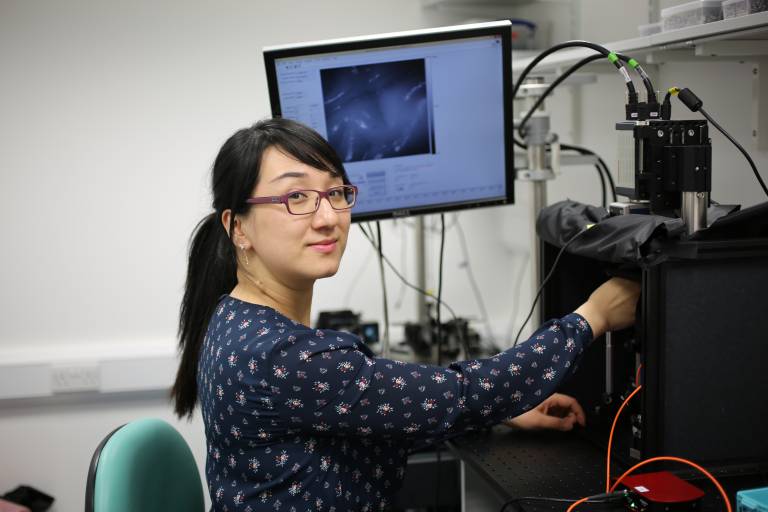#InspireAnEngineer: Spotlight on Dr Yijing Xie
8 March 2018
UK wide just one in ten engineers are women, the lowest rate in Europe.
 We want to change this.
We want to change this.
As part of our year-long campaign to #InspireAnEngineer and as it is International Women's Day on 8 March 2018, we will be featuring interviews with some of our women healthcare engineers this week. We want to highlight the ground-breaking work that they are doing advancing research frontiers and challenging stereotypes about what an engineer should like.
Dr Yijing Xie works within the Wellcome / EPSRC Centre for Interventional and Surgical Science (WEISS) at UCL as a postdoctoral research associate. She is working to develop an imaging device that can better visualise and detect patients' cancer tissue. Safe and accurate resection of brain tumours remains challenging because it is difficult for surgeons to identify exact tumour margins.
Fluorescence image-guided surgery may improve the delineation of the target tumour volume. This imaging technique works by administrating fluorescence contrast compound to patients which then makes the malignant glioma tissue glow under light excitation. This supports neurosurgeons with intraoperative guidance during brain tumour resections, helping them with real-time differentiation between tumour and non-tumour tissue and ultimately improving surgical outcomes.
Is there a particular woman in the science, technology, engineering and medicine (STEM) field that has inspired you?
This is a difficult question as there are so many inspiring women scientists that I'd love to shine a light on. I think Marie Curie is the one for me though; she was the first woman Nobel Prize laureate and the first woman Professor at the University of Paris.
I also admire how she was able to work in partnership as the equal of her husband, which was ground-breaking at the time. They were both research collaborators and family, and were able to share their Nobel Prize. My husband is also my collaborator and colleague in his work within the healthcare engineering field, so I like that parallel.
What have been the highlights of your career so far?
I've been engaged in the same research discipline, neuro-engineering, for more than 10 years. However, even working within one area, I have been able to explore a vast variety of different cutting-edge technologies including optical imaging modalities and neuro-electrophysiology and use these to address challenges in neurosurgical procedures.
I also had a rewarding maternity break and then was able to successfully return to research after six months and continue to make progress with my research advancements.
What is the most challenging aspect of your research?
I think it can be challenging to maintain balance around research and family life, and facing certain expectations around this can be particularly challenging for women in STEM.
What would you like the public to know about your research?
That this research has a clear pathway to impact on public health. The imaging system that I have developed is able to enhance a brain tumour's visibility for neurosurgeons during brain tumour resection surgery. Our aim is to translate this novel imaging technology into clinical practice and therefore improve surgical outcomes. Reducing the chance of surgical complications will improve patients' post-operative recovery and prognosis.
Where do you see your field of research being in ten years, in terms of scientific developments and advances?
Advances in technology will, again, revolutionise the concept of neurosurgery.
 Close
Close

